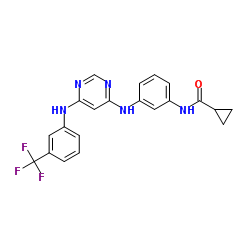EGFR-IN-12
Modify Date: 2024-01-18 16:17:53

EGFR-IN-12 structure
|
Common Name | EGFR-IN-12 | ||
|---|---|---|---|---|
| CAS Number | 879127-07-8 | Molecular Weight | 413.396 | |
| Density | 1.5±0.1 g/cm3 | Boiling Point | 605.9±55.0 °C at 760 mmHg | |
| Molecular Formula | C21H18F3N5O | Melting Point | N/A | |
| MSDS | N/A | Flash Point | 320.2±31.5 °C | |
Use of EGFR-IN-12EGFR-IN-12 is a 4,6-disubstituted pyrimidine and is a potent, ATP-competitive, irreversible and highly selective EGFR inhibitor with an IC50of 21 nM. EGFR-IN-12 also inhibits mutant EGFRL858R and EGFRL861Q with IC50s of 63 nM and 4 nM, respectively. EGFR-IN-12 displays strong selectivity for EGFR over HER4 (IC50 = 7640 nM) and a panel of 55 other kinases. EGFR-IN-12 induces cells apoptosis and has antitumor activity[1][2]. |
| Name | N-[3-[[6-[3-(trifluoromethyl)anilino]pyrimidin-4-yl]amino]phenyl]cyclopropanecarboxamide |
|---|---|
| Synonym | More Synonyms |
| Description | EGFR-IN-12 is a 4,6-disubstituted pyrimidine and is a potent, ATP-competitive, irreversible and highly selective EGFR inhibitor with an IC50of 21 nM. EGFR-IN-12 also inhibits mutant EGFRL858R and EGFRL861Q with IC50s of 63 nM and 4 nM, respectively. EGFR-IN-12 displays strong selectivity for EGFR over HER4 (IC50 = 7640 nM) and a panel of 55 other kinases. EGFR-IN-12 induces cells apoptosis and has antitumor activity[1][2]. |
|---|---|
| Related Catalog | |
| Target |
EGFR (WT):21 nM (IC50) EGFRL858R:63 nM (IC50) EGFRL861Q:4 nM (IC50) HER4:7640 nM (IC50) |
| In Vitro | EGFR-IN-12 (EGFR inhibitor 324674; 0-2 µM; 48 hours; HT29 and SW480 cells) treatment efficiently induces apoptosis at lower concentrations[2]. EGFR-IN-12 (EGFR inhibitor 324674; 0-3 µM; 3 hours; HT29 and SW480 cells) treatment inhibits EGFR activation and the downstream AKT signaling pathway in a dose-dependent manner[2]. EGFR-IN-12 (EGFR inhibitor 324674) inhibits HT29 and SW480 cell proliferation with with IC50s of 1.96 µM and 1.04 µM, respectively[2]. Pretreatment of cells with EGFR-IN-12 (compound 1; 10 µM) results in complete inhibition of wild-type receptor autophosphorylation in U-2OS cells. And the T766M mutant receptor is completely resistant to inhibition by EGFR-IN-12[1]. Apoptosis Analysis[1] Cell Line: HT29 and SW480 cells Concentration: 0 µM, 1 µM, 2 µM Incubation Time: 48 hours Result: Induced apoptosis in HT29 cells and SW480 cells. Western Blot Analysis[1] Cell Line: HT29 and SW480 cells Concentration: 0 µM, 0.1 µM, 0.3 µM, 1 µM, 3 µM Incubation Time: 3 hours Result: Inhibited EGFR activation and the downstream AKT signaling pathway in a dose-dependent manner. |
| References |
| Density | 1.5±0.1 g/cm3 |
|---|---|
| Boiling Point | 605.9±55.0 °C at 760 mmHg |
| Molecular Formula | C21H18F3N5O |
| Molecular Weight | 413.396 |
| Flash Point | 320.2±31.5 °C |
| Exact Mass | 413.146332 |
| PSA | 82.43000 |
| LogP | 5.71 |
| Vapour Pressure | 0.0±1.7 mmHg at 25°C |
| Index of Refraction | 1.682 |
| N-(3-((6-((3-(Trifluoromethyl)phenyl)amino)pyrimidin-4-yl)amino)phenyl)cyclopropanecarboxamide |
| N-{3-[(6-{[3-(Trifluoromethyl)phenyl]amino}-4-pyrimidinyl)amino]phenyl}cyclopropanecarboxamide |
| N-{3-[(6-{[3-(trifluoromethyl)phenyl]amino}pyrimidin-4-yl)amino]phenyl}cyclopropanecarboxamide |
| Cyclopropanecarboxylic acid-(3-(6-(3-trifluoromethyl-phenylamino)-pyrimidin-4-ylamino)-phenyl)-amide |
| EGFR Inhibitor |
| HMS3229E03 |
| Cyclopropanecarboxamide, N-[3-[[6-[[3-(trifluoromethyl)phenyl]amino]-4-pyrimidinyl]amino]phenyl]- |